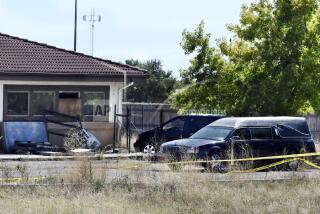2 Cemeteries Accused of Reusing Graves
- Share via
LOUISVILLE, Ky. — Things seemed amiss at the Eastern Cemetery for years. There were complaints about poor upkeep. A stray human bone was found in 1986. There was a lawsuit when a newly purchased grave was found to be occupied.
But only last spring, when a gravedigger tipped off Jim Caldwell, an investigator for the state attorney general, did the astounding details begin to emerge.
Authorities say as many as 48,000 people were buried in already occupied graves in Eastern Cemetery and Greenwood Cemetery. Both cemeteries, on Louisville’s east side, are owned by the Louisville Crematory & Cemeteries Co.
Caldwell reported finding dozens of infants buried too shallow, some as little as 10 inches below the surface, at Eastern Cemetery, and remains of more than 200 cremated bodies, many unidentified, shelved in the cellar of the crematory.
For an undetermined number of people, their “final resting place” was neither final nor restful.
A 60-count indictment issued in July alleges that some remains were unearthed so that the graves could be reused; the remains were then scattered throughout the grounds, mixed into other graves or put in a storage building.
The attorney general obtained the indictment and filed a lawsuit against the 145-year-old company and three former officers--Charles Alexander Jr., who was its executive director; Clifford B. Amos, who was company president, and Robert Copley, who was vice president.
All three men have resigned and pleaded innocent.
The cemetery company’s lawyers have said they don’t want to comment on pending litigation.
Criminal charges included corpse abuse, grave desecration, theft, improper handling of burial payments and failure to keep adequate funds in perpetual-care and maintenance trust accounts. The theft charge referred to the money received for care of the plots the company allegedly failed to provide.
The civil suit alleged numerous violations of the Kentucky Consumer Protection Act, including reuse of previously sold or occupied graves, sales of services never provided, failure to maintain graves and failure to dispose of cremated remains.
Trial on the criminal charges is scheduled in February. No date has been set for a trial on the lawsuit.
Alexander was hired in 1986 and Copley began work in 1987. Amos was acting executive director from 1980 to 1986, then became president. The alleged wrongdoings at Eastern and Greenwood began long before they joined the company.
Graves were reused on such a scale that “it would almost have to be a matter of policy” by the company, said Phillip DiBlasi, a University of Louisville archeologist who supervised excavations at the cemeteries under a court order.
“It seemed to become a relatively common practice around the early part of the century,” DiBlasi said. “Why it continued until the whistle was blown, I don’t know.”
Records indicate Eastern Cemetery probably was full shortly after the turn of the century. It had enough room for about 18,000 bodies under current industry standards, but 51,000 may have been buried there, according to DiBlasi and Caldwell.
Caldwell’s report also estimated that 15,000 bodies too many were buried at Greenwood.
The cemetery company came under scrutiny in May, when Bob Allen, a gravedigger and maintenance worker for eight years, called the attorney general’s office to report the alleged burial practices, Caldwell said.
During the investigation, Caldwell found bones stored throughout Eastern Cemetery--in a truck’s glove compartment, in a tool box, in a storage shed, in dirt piles and even in a fast food hamburger bag, his report said.
DiBlasi said he had uncovered a number of old headstones or headstone fragments in Eastern, some of which appeared to have been deliberately buried.
Graves that were dug up for reuse typically were very old, unlikely to be missed by anyone today, DiBlasi said.
More to Read
Sign up for Essential California
The most important California stories and recommendations in your inbox every morning.
You may occasionally receive promotional content from the Los Angeles Times.













